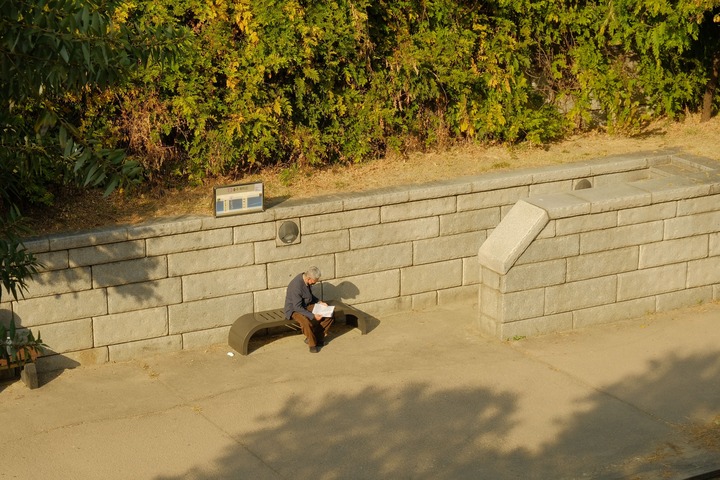
The Age-Old Enigma
by Lauren Homan | March 30, 2023
Staring at my reflection, I wonder at which point wrinkles began to ambush my smile lines and frame my fatigued eyes. As I paint Maybelline’s ‘Instant Age Rewind’ over my dark under-eyes, it dawns on me that my intense concentration frown increasingly renders me a Hagrid lookalike. My phone lights up with a notification from the news app. Enticed by the headline ‘The Cure to Ageing’, I tap open the article. Cure? Reading on, I find myself amidst another existential crisis – the prospect of biochemically deterring ‘the ageing epidemic’ seems an imminent possibility. The screen dims and my ghastly reflection stares back at me. Eternal youth doesn’t sound like the worst thing right now…
Thought to control what we look like, how we’ll look in 10 years and how our body responds to hitting the ‘eligible for free bus pass’ mark, the discovery of DNA transformed science. Upon completion of the first full sequence of human DNA, UK science minister Lord Sainsbury modestly declared that ‘we now have the possibility of achieving all we ever hoped for from medicine!’. Unfortunately, his remark was soon proved plain hyperbole and its discovery led to infinitely more questions. Modern biology instead likens DNA to a script; different productions use the same script, but each director adds their own stage directions, sets, costumes. Though basic genetic code does not massively differ from person-to-person, edits, modifications and instructions render us wholly unique individuals. Interestingly, precisely how we age remains a debate in the world of science; still, it’s generally agreed that ageing involves damage to the DNA – the director spills coffee over the script, hiding some of the crucial lines (think ‘you haven’t experienced the epic highs and lows of high school football’). As we age, our DNA accrues more damage.
The science behind how we age, however, doesn’t tell us its significance. Different cultures attach myriad meanings to ageing, moulding social structures and traditions. Many Eastern societies are recognised for treating ageing as a sacred process. In Japan (whose average life expectancy is 101 for babies born in 2021), nearly every aspect of life has been adapted to care for a growing elderly population. Social policies, business strategy to the labour market, public spaces and private homes come together to craft a society catered to the elderly. Communal bathing is reserved most days until early afternoons for seniors to exercise, socialise and cleanse. Train platforms across the country have a notch on the base of each seat to carry a walking cane. Singapore has also taken proactive measures to cope with a rapidly ageing population, such as a frailty screening program piloted in hospitals in the north-east, aiming to identify, prevent and hinder frailty at early stages. Directed towards people over 55, this screening assesses balance, flexibility and cardio-respiratory endurance. If individuals are showing signs of frailty, they can be subscribed to a 4-month programme conducted by physiotherapists and dieticians aiming to improve both physical activity and nutrition.
Norway and Sweden similarly approach ageing in a multifaceted manner. Besides fjords and midnight sunsets, these Scandinavian countries have a variety of innovative programs which foster peaceful passages through life. Sheep and chickens wander around nursing homes for residents to care for; seniors with dementia live on small working farms to participate in activities they remember from childhood.
By somewhat stark contrast, the UK media has described its growing ageing population as a ‘grey tsunami’. Though the NHS makes a great effort to care for those unable to support themselves, it is no secret that the system is imperfect – evidence of neglect in care homes across the UK has surfaced across the media. While practical measures, such as improving nationwide accessibility, have been considered, emotional attitudes to ageing, which are inherently prejudiced, are dismissed. Like many, I am guilty of being struck by a wave of sadness when I see an old person alone. Stressing about a parent or grandparent – though it may come from a place of love, emphasises the lack of independence we associate with age. It is scary to picture yourself as a burden on your family and community simply because you are a product of time.
As we age, 68-year-old Japanese physician and caregiver, Yamanaka, says there are three essential needs to ensure peace of mind: a place where we feel we belong, a purpose in life, and a sense of self-esteem. Is our problem that we fail to synergise the three? Ageism is a product of a society that promotes a future-fixated lifestyle, reinforcing the idea that competence attenuates as the clock ticks. Perhaps our society must look beyond healthcare and economic provisions to consider social situations which might enable this sense of purpose and self-esteem, post-pension.
Peace of mind is often hindered, though, by a noticeable change in physical appearance. Even my 17-year-old sister now adds retinol and anti-ageing eye cream to her skin routine. Countries celebrated for revering their older populations, like Japan, still set a precedent for perfectly preserved skin through strict SPF usage, routinely cleansing, and a huge anti-ageing beauty market. While different societies attach varying significance to ageing, they seem to be united by their desire to slow the early onset of wrinkles, manifesting in a plethora of weird and wonderful practises throughout time. Almond, moringa and castor oil remedies were commonly used in ancient Egypt for keeping skin smooth, soft and wrinkle-free. Texts from ancient Greece reveal wealthy women opted to stay out of the sun, as it was known to age the skin. The Countess of Hungary’s 15th century technique of bathing in the blood of young women to retain their youth was slightly less widespread.
Fast-forward a few hundred years where scale-breaking average ages dominate the headlines, and suddenly the global anti-ageing market is predicted to reach £220 billion by 2024. Alluring advertisements displaying beautiful skin win us over, and we are £50 down in exchange for a 25-millilitre bottle of cream. Feeding into widespread ageism, sly marketing targets people at their most insecure – more often than not, women, who have historically been held to the highest of beauty standards. Post-cream application, we’ll fork out another £40 to cop a top-of-the-market concealer.
And we continue to push towards seeking a longer-term, medical solution to age-related complications, testing the limits of scientific capability. While this does mean I stand a better chance at receiving a letter from the King, it begs the question of whether ageing must now be treated as a disease – modern biology increasingly classifies it as such.
Dr David Sinclair – co-director of the Centre for Biology Ageing Research at Harvard Medical School – has dedicated his life’s work to curing the disease of age. Rather than treating age as a natural process, Sinclair wishes to eradicate ageing due to its association with an onset of medical challenges. His work published in Cell this January declared it possible to induce and reverse the effects of ageing in mice, restoring biological signs of youthfulness. Sinclair proposes that we erase and rewrite our genetic stage directions, not with the intention to lengthen the play but to keep the audience engaged from start to finish. He claims his research marks a ‘paradigm shift’ in how to think about ageing. Great! No longer must signs of time be etched into our faces, nor copious amounts of money be poured into placebo beauty products. Swap out the filler for a fresh set of gene edits.
For Sinclair, the elimination of ageing is necessary to relieve human suffering. He forgets, however, that human suffering is not merely biological. When ageing is treated as a disease, will this technology depreciate the dread of age or the joys of youth? Will erasing the process unravel the tightly wound cultural strings which encapsulate societies? And when it’s only enjoyed by the most privileged among us, what will it mean for the rest of us? Though Peter Pan savours childhood, I tend to side with Wendy in that to live is an awfully great adventure, and journeying through time is a rite of passage – one which necessarily involves growing old. Hopefully also in a way that meets Yamanaka’s needs; ensuring a sense of purpose, a motivation to live. Elsewhere, conscious social efforts to improve the lives of the elderly have reaped fruitful results. In 2020, Japan launched eight ‘living labs’ where nursing robots provided care to its residents. Caring for seniors, the project also acts to ease the burden of care on younger generations. Ageing is treated as a natural process, instead of something to cure. The social, rather than medical, approach is certainly more realistic, accessible, and encouraging than Sinclair’s technique. To me, this is far less dystopian than edited genes and eternal youth.
To age is to experience the joys and perils of time. It is a powerful, slightly terrifying, but altogether wonderful thing. Intervening with the biochemical process may appear to be a utopic solution, but would dilute spiritual and cultural traditions, heighten social inequalities, and prey upon age-related insecurities. The ‘paradigm shift’ Sinclair refers to might instead be adopting a more positive mindset towards ageing, in which social integration and support maintain healthy, happy societies; perhaps it may even allow me to come to terms with my increasing affinity to Nanny McPhee. Then again, I didn’t do a gap year, so post-pension panic is yet to set in. But as my back tingles with signs of fatigue and time kisses frown lines into my forehead, I certainly hope my future is one I can look forward to.
Words by Lauren Homan.
Photography by Inchan Yang.




